Modular Carpet Needs a Plan: The strategy of installation methods
by Katie Daniel | May 29, 2015 11:05 am
 [1]
[1]by Bob Reince
From ashlar and monolithic to brick and parquet, carpet tile installation methods offer varied and numerous design aesthetics. The methodology of carpet tile installation was derived in the mid-19th century at a small company just outside Amsterdam, the Netherlands. The company manufactured the world’s first carpet tile, which has since exploded into the rapidly growing industry of today.
However, installation methods are not suggestions solely for aesthetic purposes, they are strategic, technical, and integral ‘rules’ that help ensure the integrity of every modular carpet installation from both design and performance perspectives. This article discusses installation methods, challenges installers and companies face, standard guidelines, and best practices developed by technical experts.
For specifiers, the key to success is being educated on the product and knowing the specific installation techniques that must be used. It is equally important to ensure installers have accurate directives. Unfortunately, many specifiers and installers fail to follow specific manufacturer-issued guidelines, resulting in flawed installations, visually unacceptable seams, and ultimately dissatisfied clients.
The challenge
The misapplication of modular carpet is a serious, industry-wide issue. Installation guidelines are not simply recommendations, but requirements developed to ensure a well-designed outcome aligned with expectations. Contrary to popular belief, not all methods and products are equal—some products can be installed in virtually every method, while others can only use one. Modular carpet installed without the specified methods often ends up necessitating expensive replacements, but these mistakes are avoidable.
Importantly, modular carpet inherently has countless seams. However, some products provide better ‘hidden’ appearance than others due to the design characteristics, making the tile seams less apparent. The best installation is obtained when the manufacturing company’s guidelines are followed—after all, they have a vested interest in their products being represented as best as possible. Prior to the initial installation, the product should be installed in a mockup. These steps confirm whether the selected product is visually acceptable for a particular installation the client desires.
Avoidable truth
With all the readily available information, unacceptable installations still occur due to clients or specifiers not adhering to proper installation practices. Last year, for example, this author was involved in a high-profile project in which a product was incorrectly installed and ultimately rejected. The product clearly had one, and only one, method of installation—quarter-turn (described later in this article). The end-user and architect decided to install the product in a monolithic fashion, against the written instructions. Needless to say, they were not happy when the inherent pattern lines did not properly match.
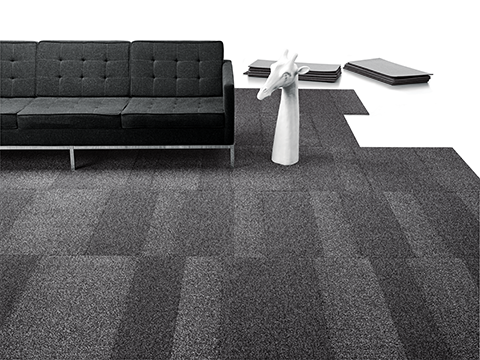 [2]
[2]The installation company unsuccessfully attempted to rearrange the tile so the pattern would match. However, they could only get 10 to 15 consecutive tiles of the pattern to match. If this was the criterion, why not install 3.6-m (12-ft) broadloom carpet? Unsurprisingly, that is exactly what the architect used to replace the carpet, at an additional expense of more than $100,000. This situation would have been completely avoidable if the recommended installation method was discussed (and even more importantly, followed).
The standard
The Carpet and Rug Institute’s (CRI) Carpet Installation Standard is the basic minimum industry-wide guideline for both residential and commercial settings. It provides a detailed outline of proper procedures and terminology used in commercial specification writing, planning, layout, and installation. The CRI Installation Standard also includes guidelines for floor preparation and installation in special areas, diagrams, and charts.
The CRI Installation Standard represents more than 25 years of information-gathering and installation expertise compiled by the members of CRI’s Installation Issues Management Team, comprising manufacturers, and professional installers.
CRI recommends the following as the directive for modular carpet installation:
- follow carpet manufacturer recommendations regarding application, squareness, and location
of working chalk lines; - install modular carpet on 90-degree format with corners aligned according to manufacturer specifications;
- geometry (e.g. monolithic, ashlar, and quarter turn) is required to be agreed on by all parties before installation begins.
Regarding joints, modules in the completed installation should be tight, but not compressed. To ensure proper spacing when installing modular carpet, the distance covered by 11 modules (10 joints) installed on the floor with no visible gaps, peaks, or overlaps should be measured. Modules should be continually checked to be installed in compliance with manufacturer specifications for a particular product. It is important to ensure yarn is not trapped between modules.
 [3]
[3]However, it is important to note the instructions for some specific styles may exceed the basic minimum requirements set forth in the CRI Installation Standard. As mentioned, carpet tile seams will never be invisible—they are usually most noticeable on the day of installation. Seams become increasingly less visible with routine vacuuming and foot traffic. Manufacturers go to great lengths to determine how a particular style should be installed to help maximize its appearance in all standard color combinations. The various styles and tile sizes make it extremely important for the installer to know whether the preferred installation layout for a particular style is monolithic, brick, ashlar, quarter-turn, or herringbone.
Recommended installation layouts are included on the identifying labels affixed to the tile boxes or included as an individual paper insert in each container. They can also be usually found on the manufacturer’s website. Not only should specifiers validate the product and method, the installation company should do the same prior
to installation.
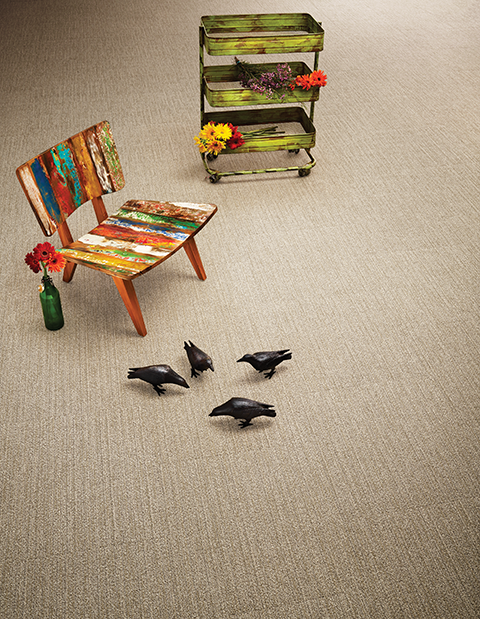 [4]
[4]Standard installation methods
Figure 1 provides a list of industry-wide methods used to install modular carpet. The top row is plank tile (457 x 914 mm [18 x 36 in.]) and the bottom row represents square tile (610 x 610 mm [24 x 24 in.]). Manufacturers should recommend the best method for each style based on the color, pattern, and construction of the product. Most companies keep the installation direction consistent by stamping an arrow on the backing as illustrated below.
The most commonly used installation methods used in the carpet industry are:
- ashlar: all arrows should point in the same direction with the tile seam displaced by half a tile in the length direction;
- herringbone: arrows should appear to be interwoven and point in two different directions, creating a herringbone pattern;
- brick: all arrows should point in the same direction with the tile seam displaced by half a tile in the width direction;
- parquet: doubled tile arrows should point the same direction in both the length and width directions;
- monolithic: all arrows should point in the same direction (also referred to as ‘broadloom,’ this is one of the most popular methods; it keeps the design/pattern consistent);
- quarter-drop: tiles are turned 90-degrees to one another with the tile seam displaced by half a tile;
- quarter-turn: tiles are turned 90-degrees to one another (also referred to as ‘checkerboard’ or ‘tessellated’); and
- random: tiles installed without regard to direction and orientation.
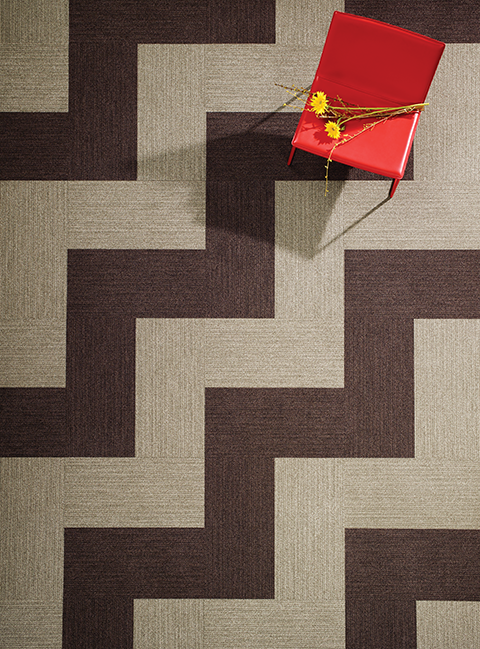 [5]
[5]Depending on the method, the most efficient way to begin an installation is to start in the corner of the room and work away from there. In certain instances, as with a bold pattern, one may find the need to mark off a room, find the center point, and start laying the tiles from there.
Recommendations
Most modular carpet manufacturers develop recommended installation methods according to their individual designs and product line. The following is step-by-step information on the process of how some manufacturers adopt the best practices of modular carpet installation methods specific to their products.
Some styles allow for various installation layouts. Others have only one or two recommended layout methods to assure an acceptable aesthetic for the client. This is not to say a client cannot install modular carpet in a non-recommended method, but the chances of unacceptable appearance or visually poor seam appearance is a likely by-product of such decisions.
How do carpet manufacturers develop recommended installation methods according to their specific brand/designs of carpet tiles?
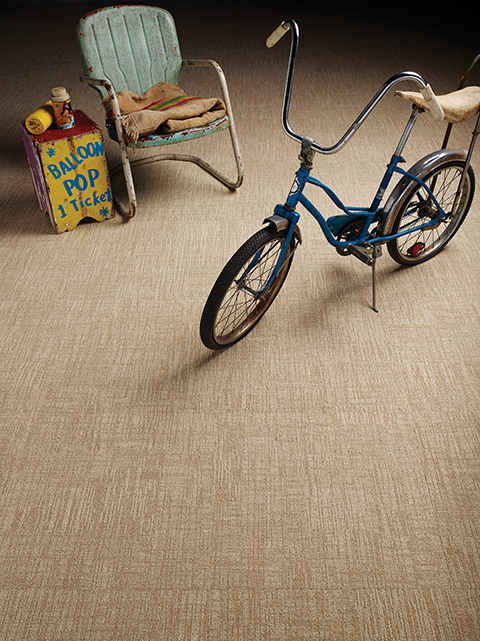 [6]
[6]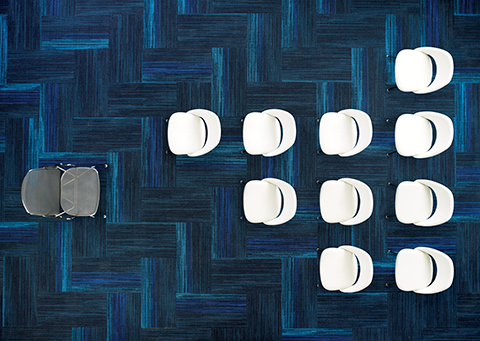 [7]
[7]Step 1
If carpet is manufactured in 1.8-m (6-ft) widths, it can go from production directly to the tile line for backing application and ‘clicking’ off into desired tile sizes of:
- 457 x 457 mm (18 x 18 in.);
- 610 x 610 mm (24 x 24 in.);
- 914 x 914 mm (36 x 36 in.); or
- 457 x 914 mm (18 x 36 in.)
The 3.6-m (12-ft) wide carpet is cut to 1.8-m (6-ft) wide rolls and then subject to the same procedure.
To determine a recommended installation method, a physical installation mockup must first be created. This entails installing the modular carpet in all possible methods and effectively grading the appearance both in product and general seam ability. The decision to not recommend a particular installation method is decided at this juncture. During the mockup phase, products are critiqued by upper management, product design, manufacturing, and field technical services personnel for appearance and recommended installation practices.
Step 2
If the product’s appearance is approved, it is then examined on a seam appearance level, subjecting it to the many methods of carpet tile installations. In this phase, the true installation methods come to light. Seam appearance by product varies widely by install method—when a product is approved for a specific installation method, it means the general public will not find the seams objectionable. This process eliminates the speculation for product-specific carpet tile installations, yields an endorsed installation method tailored to each product, and is assured by the company’s best practices for products.
Step 3
With each product, company-approved guides for proper carpet tile installation methods are provided with basic visual layouts and reference materials. If there are any questions about the recommended layout, the company should be available to clients to provide assistance. However, the best and safest practice is to show the potential client a physical mockup to gain approval for a ‘no-surprise’ installation appearance. With the client’s approval on the mockup level, and the manufacturer’s approval from the manufacturing side, satisfaction is inherently the result.
Conclusion
Carpet tile installation methods provide clients with numerous aesthetic options. The versatility of carpet tiles is what makes it an interesting material. There are many distinctive tile sizes, shapes, patterns, and colors. Depending on the shape and size, designers can create unique projects. The caveat to remember is not all products can be installed in all installation methods, but with the recommended foundation and a solid plan, one can develop successful designs.
Bob Reince is the senior director of technical services at Bentley Mills. Initially joining as assistant manager of technical services in 1989, he grew with the company and was sought out to venture to new opportunities in 1999. However, he remained in the technical and field service divisions of the commercial carpet industry at the top of his level. Coming full circle, Reince rejoined Bentley in April 2012, assisting in its newest rebranding strategy on the technical service level. He can be reached via e-mail at bob.reince@bentleymills.com.
- [Image]: http://www.constructionspecifier.com/wp-content/uploads/2015/05/carpet__M5A2133.png
- [Image]: http://www.constructionspecifier.com/wp-content/uploads/2015/05/carpet_Magnetism-18x26-Brick.png
- [Image]: http://www.constructionspecifier.com/wp-content/uploads/2015/05/carpet_Figure-1.png
- [Image]: http://www.constructionspecifier.com/wp-content/uploads/2015/05/carpet_Paris-Tweed-Ashlar-24x24.png
- [Image]: http://www.constructionspecifier.com/wp-content/uploads/2015/05/carpet_Paris-Tweed-18x36-Parquet.png
- [Image]: http://www.constructionspecifier.com/wp-content/uploads/2015/05/carpet_Salt-creek-24x24-Monolithic.png
- [Image]: http://www.constructionspecifier.com/wp-content/uploads/2015/05/carpet_Tiger-Patrol-18x36-Herringbone.png
Source URL: https://www.constructionspecifier.com/modular-carpet-needs-a-plan-the-strategy-of-installation-methods/